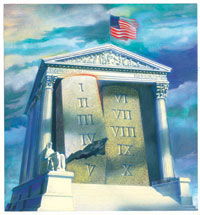Stone Words
Marci A. Hamilton September/October 2002
Getting your Trinity Audio player ready...
By Marci A. Hamilton Illustration By Sally Wern Comport The Supreme Court recently denied certiorari in a case testing whether state government could post the Ten Commandments. At the same time, a federal district court in Pennsylvania held that the government's display of the commandments violates the establishment clause. As I have noted in my www.FindLaw.com column, serious constitutional problems arise when the government displays the Ten Commandments. The typical defense is that the commandments are the ground for much of our criminal law and therefore constitute a legal and historical document—not a religious one. But this argument, upon examination, is so weak that it ought to be rejected out of hand. Indeed, the only real question the argument raises is why some courts have found its flawed logic persuasive. To that question, I will offer two possible answers. Dividing the Ten Commandments in Two The misguided argument that the Ten Commandments are merely legal and historical treats them as though they are an indissoluble whole. Of course, they are not. To be sure, the principles expressed in the last six commandments—honor thy mother and father, don't kill, don't commit adultery, don't steal, don't lie, and don't covet—can be found in various aspects in many laws in the United States. The first four commandments, though, contain directives that no government official in this land of religious liberty may say or endorse on behalf of the government. Were the president to give a speech (which he, of course, would not) reminding Americans to obey the first four commandments—there shall be only one God, there shall be no graven images, do not take the Lord's name in vain, and keep holy the Lord's day—there would be a huge uprising in opposition. Those are not messages this government may endorse, and thank God for that. Similarly, when the government displays the Ten Commandments by themselves, the unconstitutional endorsement of a particular religion is patently obvious. This is not a hard case, despite the divisions among the courts that have addressed the issue. The hard case is whether they can be displayed along with other historical sources of the law as an educational tool. This one is hard, because it depends on context and the viewers' likely interpretation. No one believes that the Ten Commandments can never be displayed; that would be ridiculous. The trick is displaying them in a way that does not carry the government's endorsement of their religious content. Discrimination Against Nonbelievers So how does one explain the lower courts' inability to embrace the clear, simple, and obviously true proposition that the Ten Commandments are religious? The answer is that there are two forces at work in these cases that tend to muddy the constitutional waters. First, the most reviled minority in America is characterized neither by race nor sex nor religion, but rather by a lack of religious belief. When nonbelievers challenge government- backed religious messages, they are typically treated with contempt and often face threats and harassment, as well. For example, in the Pennsylvania case the female plaintiffs—atheists who brought the suit with the help of the ACLU—were threatened and harassed both before and after the court's decision validating their argument. In Texas, students challenging government-sponsored prayer at football games asked (and were granted the right) not to be named in the lawsuit, so they could avoid harassment. Who are the actual and feared harassers? Believers, of course. This is an unfortunate example of the intolerance of a majority whose members ought to know better. After all, if the believers were to be told by the government that they must stop believing in God tomorrow, they would heat up their lobbying machines and their members to a fever pitch. Their representatives in the state and federal legislatures would self-righteously decry the violation of the believers' rights. Believers know well how to defend, and defend strenuously, their rights to believe as they choose—as well they should. But when nonbelievers suggest that the government ought not endorse a religious message, the same believers tell the nonbelievers to "get over it" and move on to another issue. If the nonbelievers, too, must have their own views, they should at least keep them to themselves when they conflict with the believers' agenda. The believers' attitude is: Commitment and conviction for me but not for thee. And you can be sure no member of Congress or a state legislature will defend the nonbelievers' rights. As a believer I find this all rather embarrassing. I find embarrassing and unfortunate, too, believers' efforts to lobby for government support for their beliefs—whether through the posting of the Ten Commandments or otherwise. Actions such as these make all believers look bad. Religious Connotation Retained The second argument that has muddied the waters for courts is the claim, recently repeated again and again, that the Ten Commandments can be displayed by the government because they have lost their religious connotation. According to this argument the commandments are nothing but legal history. Think about this. Government, pandering to religious voters, goes out on a limb, engaging in expensive and risky litigation, to defend the display of a document that is deeply religious for both Jews and Christians, on the theory that it is no longer truly religious. The very reason that the government is attempting to post the commandments—because believers so fervently want them posted—belies the claim that the commandments are not religious. This is secularization as a cover for the drive to power, and it is too transparent to be believed. The next time a believer complains about "secularization," one might ask who has been pushing the theory of secularization the hardest, and for what purpose. Those who bemoan the alleged "loss" of the power of religion in public life should pause before attempting to drain a powerful, moving, sacred, and overwhelmingly significant religious document of its power by pretending it is not even religious in the first place. Sometimes ends do not justify the means, particularly when the means involve being disingenuous about the very institution one is purportedly defending. The Hegemony that Never Existed At the heart of the debate over the public display of the Ten Commandments is a struggle that always has existed but that has become more pitched as the United States has matured. In the wave of Asian and European immigration in the late nineteenth century, Protestants responded by embracing the phrase "a Christian nation" in legal opinions and popular editorials. Despite these protestations, our religious diversity continued to increase through the twentieth century and into the twenty-first. Even so, some Christians have held tight to the belief that this is "their" country, and therefore their symbols deserve government endorsement in the public square. The problem with this vision is that this country has never been one of a singular religion. It is an abstraction to argue that this was a unified Christian country even at the time of the framing of the Constitution, when Christian sects battled for political control, the right to be the established church, and not infrequently expelled nonbelievers from their communities. The Quakers were important in introducing tolerance, but that tolerance was sorely needed because of the religious diversity present from the beginning. Harvard professor Diana Eck has written a fascinating book documenting the current diversity in religious belief and practice, A New Religious America: How a "Christian Country" Has Become the World's Most Religiously Diverse Nation. For anyone who continues to insist that this country is any single religion and that any religion's symbols have a right to a place of power, this book is a strong corrective. Hindus, Buddhists, Muslims, and Sikhs are no longer fringe religions but, rather, thriving communities of Americans. Those pushing display of the Ten Commandments would say at this point: Even if there are many religions now, the religion that is the foundation of America is Christianity, and therefore its symbols deserve pride of place. This is a beguiling argument, but it is offpoint. There is no doubt—and actually my life's academic work is devoted to this subject—that principles found in some Christian theologies were interpolated by the framers and incorporated into the Constitution. The organizing principles of the Presbyterian Church, for example, were an important source of ideas for some of the most influential framers, for example, James Madison and James Wilson. Ideas, however, do not carry with them a right of ownership. They are not indelibly stamped with "Owned by—." Rather, they travel and mingle with others. In the case of the Constitution, it was a blend of theological, philosophical, and political ideas combined with practical insights. That the framers borrowed some Christian ideas that were powerful at the time of the framing does not mean that Christians can claim ownership of the Constitution. Even if our legal system borrowed principles from the Ten Commandments (elements of which actually appear in other religious traditions as well), that does not make the system Christian, or owned by any Christian religion. Christians should be proud of the contributions of their tradition's ideas, but that is a far cry from instituting a right to claim ownership of either the legal or cultural construct. Indeed, the constitutional and legal experiment in the United States is not validated so much by its Christian sources as by the fact that it has succeeded. It is true with constitutions as with everything else: nothing succeeds like success. The Future When the Supreme Court finally addresses the Ten Commandments issue, which it eventually will, one can only hope that the justices take the straight path on this issue. They did so in an earlier, and equally easy, decision when they declared that school-sponsored football game prayers violate the establishment clause. That case echoed their earlier, and correct, decision that school-sponsored prayers at high school graduations send a message of endorsement that disenfranchises those who do not believe in the content of the prayer. Because of these precedents, there is good reason to hope that the religious liberty set in motion by the Constitution will continue to flourish in this land of religious diversity. That vision of religious liberty is the antidote for religious tyranny. 
______________________ Marci A. Hamilton is Paul R. Verkuil Chair in Public Law at Benjamin N. Cardozo School of Law, Yeshiva University, Washington Heights, New York. While it was reframed by Marci for our Liberty readers, many of the elements in this article come from her column at www.FindLaw.com Article Author: Marci A. Hamilton
test for sheldon
|

